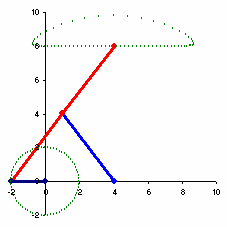Numerical Methods - First derivative using Excel formula
Numerical methods can be very helpful for calculation of mechanical engineering design. What I would like to introduce in this post is about calculation of the first derivative using numerical methods in Microsoft Excel without using any math software.
From the textbook, there are a lot of formula and explanation about how we get this formula. So I would skip that part and directly start with the selected formula as an example.
We know that the first derivative of function f(x) can be calculated from the following equation

It is the formula to calculate first derivative using interior points that give the error of h4
That means we will use the values of function at other 4 points around the center of interest to calculate the first derivative and the smaller the step size (h), the higher accuracy of calculation result.
The following is the equation of favorite cam curve - Cycloid

The cam follower will slowly move at the beginning of time and start accelerating, then decelerating in the middle of time and slowly stops at the end of movement. This give smooth motion of cam mechanism.

We can calculate the velocity of the cam follower using the following formula.

What we have to do is to make a table in excel and enter the formula of f(x), for this case, it's the cycloid motion function.

The above table is calculated using 1.25 deg for each step. But the real value of h should be calculated from 1.25 x Pi/180 = 0.021816616 rad.
Then we can calculate the velocity at each point using the formula explained above.
Example: to calculate the first derivative of cycloid motion at 15 deg
If camshaft speed = 50 rpm, then omega = 2 x Pi x 50/60 = 5.235987756 rad/s
Then the velocity at 15 deg can be calculated from

f'(15 deg) = [-4.20358 + 8x3.48065 - 8x2.23829 + 1.72606]/(12x0.021816616) x 5.235987756 = 149.2272246 mm/s = 0.1492 m/s
If we do the same calculation for the remaining points, we can then get the velocity profile of cycloid motion. Try it yourself and get the result as follows,

No need to use any math software. Excel can easily help you calculate first derivative using knowledge of numerical methods.
From the textbook, there are a lot of formula and explanation about how we get this formula. So I would skip that part and directly start with the selected formula as an example.
We know that the first derivative of function f(x) can be calculated from the following equation

It is the formula to calculate first derivative using interior points that give the error of h4
That means we will use the values of function at other 4 points around the center of interest to calculate the first derivative and the smaller the step size (h), the higher accuracy of calculation result.
The following is the equation of favorite cam curve - Cycloid

The cam follower will slowly move at the beginning of time and start accelerating, then decelerating in the middle of time and slowly stops at the end of movement. This give smooth motion of cam mechanism.

We can calculate the velocity of the cam follower using the following formula.

What we have to do is to make a table in excel and enter the formula of f(x), for this case, it's the cycloid motion function.

The above table is calculated using 1.25 deg for each step. But the real value of h should be calculated from 1.25 x Pi/180 = 0.021816616 rad.
Then we can calculate the velocity at each point using the formula explained above.
Example: to calculate the first derivative of cycloid motion at 15 deg
If camshaft speed = 50 rpm, then omega = 2 x Pi x 50/60 = 5.235987756 rad/s
Then the velocity at 15 deg can be calculated from

f'(15 deg) = [-4.20358 + 8x3.48065 - 8x2.23829 + 1.72606]/(12x0.021816616) x 5.235987756 = 149.2272246 mm/s = 0.1492 m/s
If we do the same calculation for the remaining points, we can then get the velocity profile of cycloid motion. Try it yourself and get the result as follows,

No need to use any math software. Excel can easily help you calculate first derivative using knowledge of numerical methods.




Comments
Hoping for your reply asap. Hehe. I'm finishing my lab report for tomorrow.
I would extend the table and calculate f(x at i-1) and f(x at i-2) like this...
f'(0 deg) = [-f(2.5 deg) + 8xf(1.25 deg) - 8xf(-1.25 deg) + f(-2.5 deg)]/(12x0.021816616) x 5.235987756 = 0.00230668 mm/s
also for f'(1 deg) can be calculated from
f'(1.25 deg) = [-f(3.75 deg) + 8xf(2.5 deg) - 8xf(0 deg) + f(-1.25 deg)]/(12x0.021816616) x 5.235987756 = 1.405807453 mm/s
We can compare this approximated values with the exact solution.
f'(theta) = hm/bm[1 - cos(2*pi*theta/bm)] x omega
from this formula we get
f'(0 deg) = 0 mm/s
f'(1.25 deg) = 1.403529172 mm/s
Ake